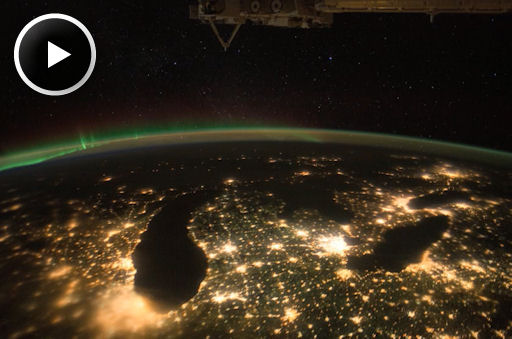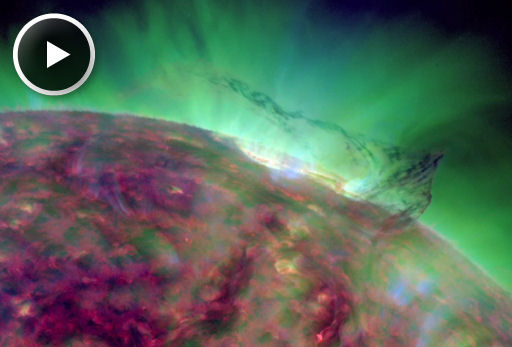SUNSPOT OF INTEREST: For the second day in a row, sunspot AR1416 has doubled in size: movie. Moreover, it has developed a "beta-gamma" magnetic field that harbors energy for M-class solar flares. Any such eruptions this weekend would be Earth directed as the sunspot turns to face our planet. Solar flare alerts: text, voice.
THE VIEW FROM ABOVE: On Friday, Feb. 10th, NASA released a new set of videos from the International Space Station that officials said was among "the most spectacular night imagery ever taken from space of the United States." After watching the following movie (48 MB), you might find it hard to disagree:
NASA describes the footage: "The sequence of shots was taken January 30, 2012 from 06:13:36 to 06:23:09 GMT, on a pass from northern Mexico to northwest New Brunswick. The video begins looking northeast over Texas, where cities like San Antonio, Houston, and the Dallas/Fort Worth area can be seen. Oklahoma City, Kansas City, and St. Louis are easily distinguished as the ISS continues northeast over the Great Plains. The video concludes with Chicago illuminating the southern edge of Lake Michigan, and auroras shimmering in the distance over Canada."
The auroras in the video appeared on a relatively uneventful night, geomagnetically speaking, when a CME completely missed Earth. Apparently, even the quiet nights are spellbinding onboard the ISS. Aurora alerts: text, voice.
NORTHEASTERN ERUPTION: Solar activity is picking up. During the late hours of Feb. 9th, a dark magnetic filament winding over the sun's northeastern limb rose up and exploded. NASA's Solar Dynamics Observatory recorded the action:
The eruption hurled a bright coronal mass ejection (CME) away from the sun: SOHO movie. The expanding cloud is not heading for Earth, but in a day or so it might make contact with Venus, which appears to be in the line of fire.

![]()
Solar wind
speed: 380.6 km/sec
density: 0.1 protons/cm3
explanation | more data
Updated: Today at 1436 UT
![]()
X-ray Solar Flares
6-hr max: C7 1004 UT Feb11
24-hr: C7 1004 UT Feb11
explanation | more data
Updated: Today at: 1400 UT
![]()
![]()
![]()
Daily Sun: 11 Feb 12
![]()
![]()
Sunspot AR1416 has a "beta gamma" magnetic field that harbors energy for M-class solar flares. Credit: SDO/HMI
![]()
![]()
![]()
Sunspot number: 51
What is the sunspot number?
Updated 10 Feb 2012
Spotless Days
Current Stretch: 0 days
2012 total: 0 days (0%)
2011 total: 2 days (<1%)
2010 total: 51 days (14%)
2009 total: 260 days (71%)
Since 2004: 821 days
Typical Solar Min: 486 days
Updated 10 Feb 2012
The Radio Sun
10.7 cm flux: 111 sfu
explanation | more data
Updated 10 Feb 2012
![]()
![]()
![]()
Current Auroral Oval:
![]()
Switch to: Europe, USA, New Zealand, Antarctica
Credit: NOAA/POES
![]()
![]()
![]()
Planetary K-index
Now: Kp= 0 quiet
24-hr max: Kp= 2 quiet
explanation | more data
![]()
Interplanetary Mag. Field
Btotal: 3.7 nT
Bz: 1.1 nT north
explanation | more data
Updated: Today at 1437 UT
![]()
![]()
![]()
Coronal Holes: 10 Feb 12
![]()
![]()
Solar wind flowing from this coronal hole should reach Earth on Feb. 10-11. Credit: SDO/AIA.






